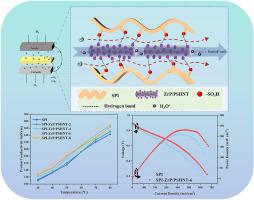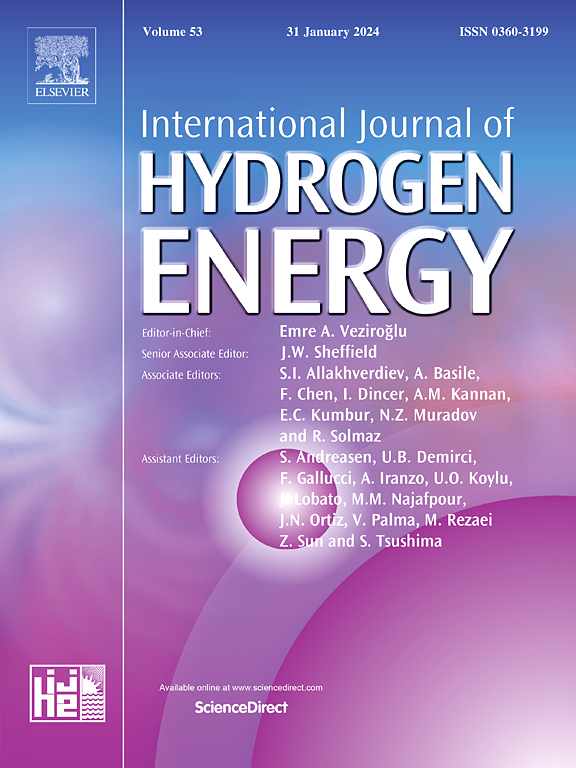基于多质子传输通道的三维自组装结构构建高质子电导率质子交换膜
IF 8.1
2区 工程技术
Q1 CHEMISTRY, PHYSICAL
引用次数: 0
摘要
质子交换膜由于其可调质子传输通道的设计而引起了人们的极大兴趣。然而,复合膜中质子输运通道的构建仍然面临着巨大的挑战。本研究设计并制备了磷酸锆(ZrP)和聚二烯基二甲基氯化铵(PDDA)改性磺化高岭土(PSHNT)静电自组装增强纳米复合材料复合膜。此外,由于ZrP和PSHNT的协同作用,在膜内构建了远程有序的质子传输通道。结果表明,ZrP纳米粒子和PSHNT的酸性基团产生了更多的质子有效输运的酸性位点,而空心管型高岭土通过车辆型机制为质子输运提供了快速通道。ZrP/PSHNT优异的亲水性及其在聚合物基体中的良好分散性使其在80℃时的吸水率达到45.5%,溶胀率为6.4%。更令人印象深刻的是,SPI-ZrP/PSHNT-6在80°C水合条件下表现出288.2 mS cm−1的质子电导率。此外,由于其优异的质子导电性,H2-Air燃料电池的峰值功率密度高达230.2 mW cm−2。本研究所制备的质子交换膜材料性能优异,为未来氢燃料电池中高性能质子交换膜的商业化应用铺平了新的道路。本文章由计算机程序翻译,如有差异,请以英文原文为准。

Construction of proton exchange membrane with high proton conductivity based on 3D self-assembly structures as multiple proton transport channels
Proton exchange membranes are currently of a great interest due to their tunable proton transport channels in design. However, the construction of proton transport channels in composite membranes still encounters enormous challenges. In this study, a series of composite membranes composed of nanocomposites reinforced with electrostatically self-assembly of zirconium phosphate (ZrP) and poly(diallyldimethylammonium chloride) (PDDA)modified sulfonated halloysite (PSHNT) were designed and prepared. Further, long-range ordered proton transport channels were constructed in the membrane owing to synergistic effect of ZrP and PSHNT. It is revealed that acidic groups of ZrP nanoparticles and PSHNT yield more acidic sites for effective proton transport, and hollow tubular halloysite creates a fast channel for proton transport via a vehicle-type mechanism. The excellent hydrophilicity of ZrP/PSHNT and their good dispersion in polymer matrices result in a much higher water absorption of 45.5% and a lower swelling rate of 6.4% at 80 °C. More impressively, SPI-ZrP/PSHNT-6 exhibits a remarkable proton conductivity of 288.2 mS cm−1 at 80 °C under hydrated conditions. In addition, due to its excellent proton conductivity, a high peak power density up to 230.2 mW cm−2 has been achieved in H2-Air fuel cell. The excellent material performance of such proton exchange membranes in this study paves a new way towards the commercialization of high-performance proton exchange membranes in future applications for hydrogen fuel cell.
求助全文
通过发布文献求助,成功后即可免费获取论文全文。
去求助
来源期刊

International Journal of Hydrogen Energy
工程技术-环境科学
CiteScore
13.50
自引率
25.00%
发文量
3502
审稿时长
60 days
期刊介绍:
The objective of the International Journal of Hydrogen Energy is to facilitate the exchange of new ideas, technological advancements, and research findings in the field of Hydrogen Energy among scientists and engineers worldwide. This journal showcases original research, both analytical and experimental, covering various aspects of Hydrogen Energy. These include production, storage, transmission, utilization, enabling technologies, environmental impact, economic considerations, and global perspectives on hydrogen and its carriers such as NH3, CH4, alcohols, etc.
The utilization aspect encompasses various methods such as thermochemical (combustion), photochemical, electrochemical (fuel cells), and nuclear conversion of hydrogen, hydrogen isotopes, and hydrogen carriers into thermal, mechanical, and electrical energies. The applications of these energies can be found in transportation (including aerospace), industrial, commercial, and residential sectors.
 求助内容:
求助内容: 应助结果提醒方式:
应助结果提醒方式:


